“The graffiti and Street Art movements – they have all these tentacles and they can be non-linear.”
A new exhibition in Berlin’s neighborhood of Schöneberg epitomizes one of the central schisms that has vibrated through Street Art and graffiti for years: the question of where to draw boundaries between these two scenes. Each may have been born in the margins of society but are now evermore commingled. Debates aside, everyone agrees that once in the gallery space, street become fine art after all.
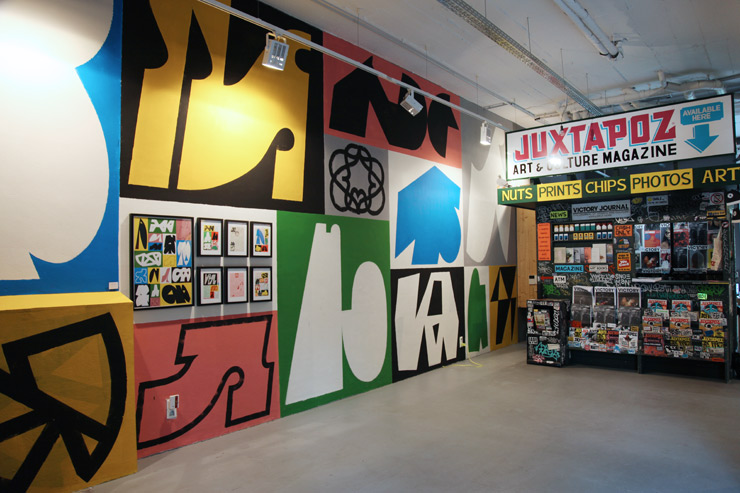
Erosie on the left with Grotesk’s Juxtapoz News Stand on the right. What In The World PM/12. Urban Nation Museum For Urban Contemporary Art. Berlin, May 19, 2017. (photo © Jaime Rojo)
As Editor-in-Chief of the San Francisco based art magazine Juxtapoz and curator of this “What in the World” show at Urban Nation’s project space, Evan Pricco is well aware of the landmines that can explode when one is negotiating the terminologies and practices of sundry sub-cultural art manifestations that have bubbled to the surface in the last decades and which now often melt with one another inextricably.
“The graffiti and Street Art movements – they have all these tentacles and they can be non-linear,” Evan says as we walk down a subterranean parking ramp to see a low, long outdoor mural by Sweden’s EKTA; an abstract series of roughly square patches that closely emulate the sewn panels he has suspended from the ceiling inside the gallery.
Speaking of the tentacles, he continues, “It can be starting points to end points – it can be end points to starting points. There are all of these different cultures that grew out of that 1970s-80s set of counter-culture art movements.”
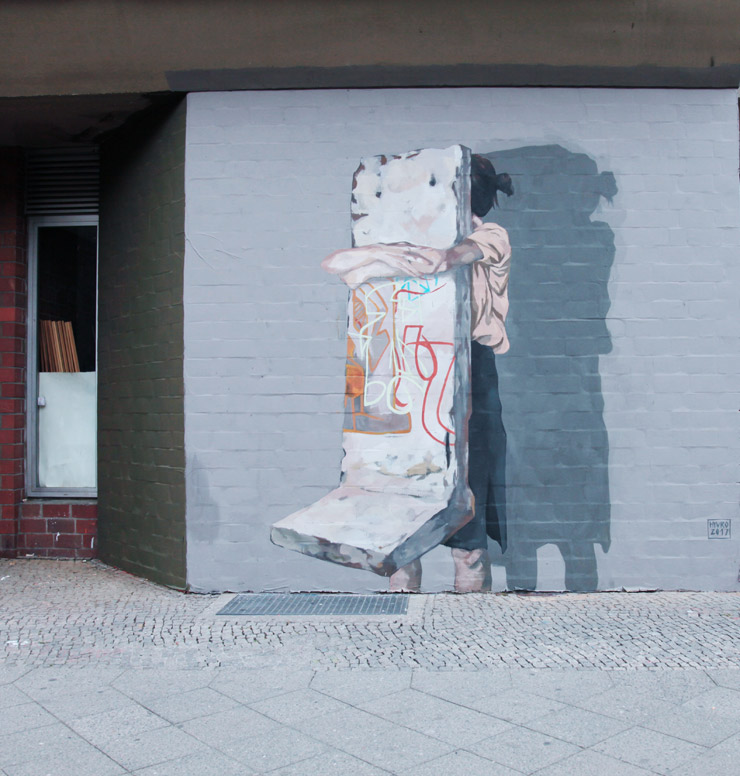
Hyuro. What In The World PM/12. Urban Nation Museum For Urban Contemporary Art. Berlin, May 19, 2017. (photo © Jaime Rojo)
“I think the people that I really wanted in this show are kind of on the periphery of that. They clearly dip their toe into those movements, are clearly influenced by them. Their practice doesn’t necessarily fit in with what is going on in Street Art and graffiti but also its informed by it.”
To introduce a new crop of artists to Urban Nation that haven’t been shown here yet, Pricco choses some of Europes street/mural/conceptual artists who emphasize color and mood, an expansionist approach that he welcomes at the magazine as well. Not surprisingly, the range reflects some of the same interests you’ll find flipping through the influential art publication; old school graffiti, commercial illustration, comic book history, abstract fine art, political art, some lowbrow, some conceptual. There is even Grotesk’s newsstand, the actual one that he designed and constructed with Juxtapoz that sat in Times Square in October 2015.
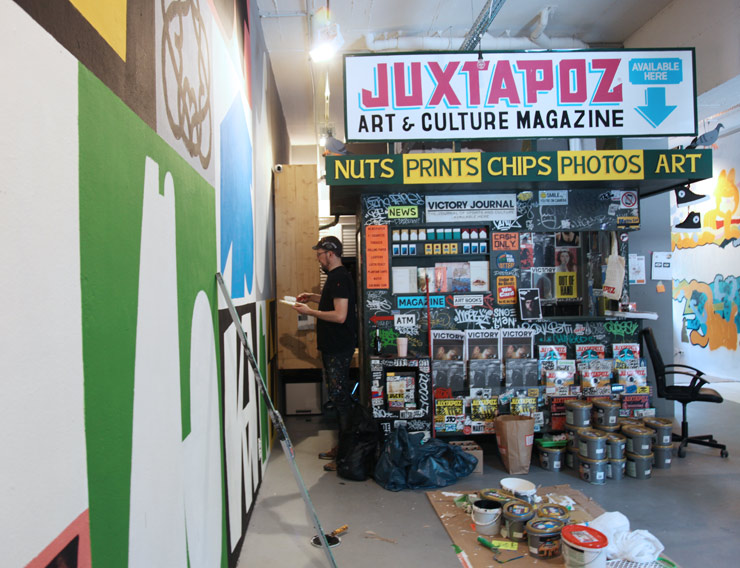
Erosie on the left with Grotesk’s Juxtapoz News Stand on the right. What In The World PM/12. Urban Nation Museum For Urban Contemporary Art. Berlin, May 19, 2017. (photo © Jaime Rojo)
Primarily from Europe and raised in the hothouse of the 1990s epic graffiti scenes that enthralled youth in many EU big cities, this group of 7 artists each has moved their practice forward – which may lose them some street cred and gather new audiences.
Included are Berlin’s Daan Botlek, Sweden’s EKTA, Ermsy from France, Erosie from the Netherlands, Hyuro from Spain, Serge Lowrider from Switzerland and Zio Ziegler from the US. If you speak to any of them, you may find the commonality is the freedom they actively give themselves to pursue an autonomous artistic route not easily categorized.
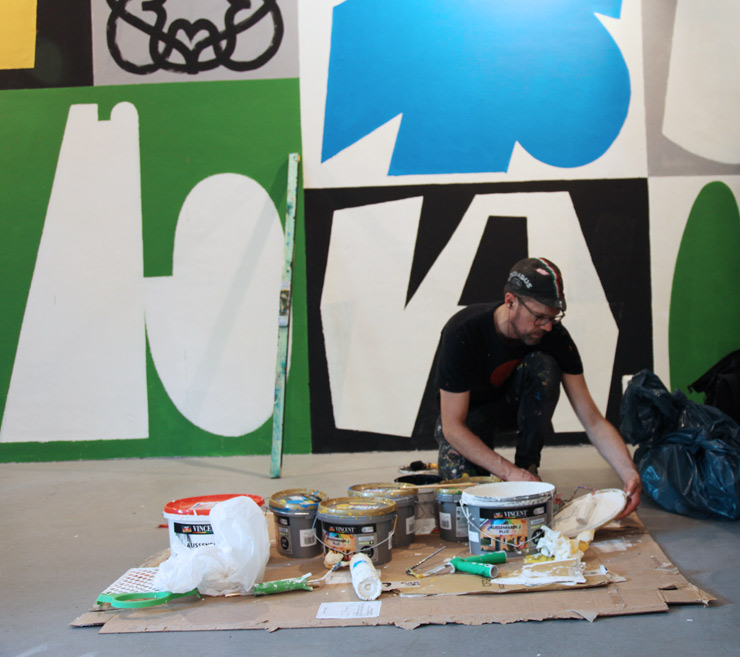
Erosie at work on his piece. What In The World PM/12. Urban Nation Museum For Urban Contemporary Art. Berlin, May 19, 2017. (photo © Jaime Rojo)
Lowrider is clearly in love with the letter-form, as is the graffiti tradition, but he steers sharply toward the calligraphic practices of crisp sign-painting and inverting the pleasantly banal messaging of advertising from an earlier era. Perhaps the tight line work overlaps with tattoo and skater culture, two creative brethren frequently in the mix in graffiti and Street Art scenes.
Hyuro uses a figurative symbolism heavy with metaphor and a color palette that is too understated for the flashy graphics that many associate with today’s mural festivals, yet she’s built a dedicated following among Street Art fans who admire her poke-you-in-the-eye activist streak. Daan Botleks’ figures wander and cavort amidst an abstractedly shaped world calling to mind the shading of early graffiti and the volumizing pointillism of Seurat after some wine.
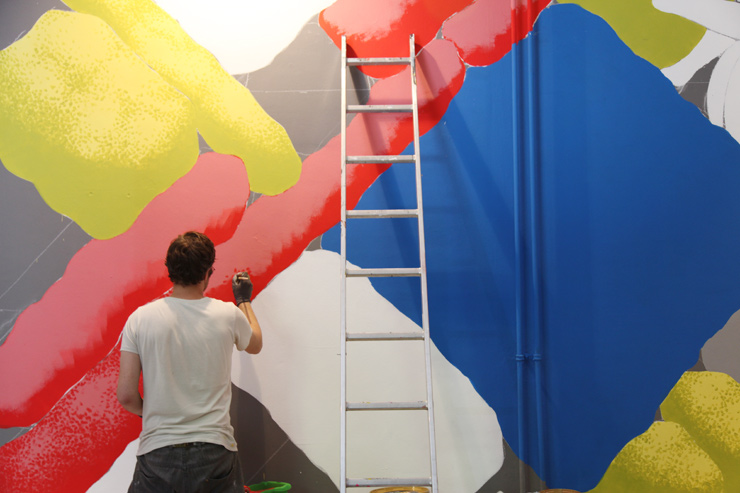
Daan Botlek at work on his piece. What In The World PM/12. Urban Nation Museum For Urban Contemporary Art. Berlin, May 19, 2017. (photo © Jaime Rojo)
Painter Jeroen Erosie emphatically will tell you that he was in love with graffiti when he first did it on the streets as a teenager – and for many years afterwards. But he says he ultimately bristled at a scene that had once symbolized freedom to him but had become too rigid and even oppressive in its rules about how aesthetics should be practiced by people – if they were to earn respect within the clan.
At Saturday nights opening along Bülowstrasse with the front doors open to the busy street and with the sound of the elevated train swooshing by overhead, Erosie explained with a gleeful certainty his process of deconstruction that led him to this point. “I removed one of the pillars of graffiti from my work and I liked the result, the change. So I started to remove more pillars, one by one,” he says, describing the evolution that transformed his letter forms and colors into these simplified and bold bi-color icons that may call to mind Matisse’s cut outs more than graffiti bubble-tags, but you’ll easily draw the correlation if you try.
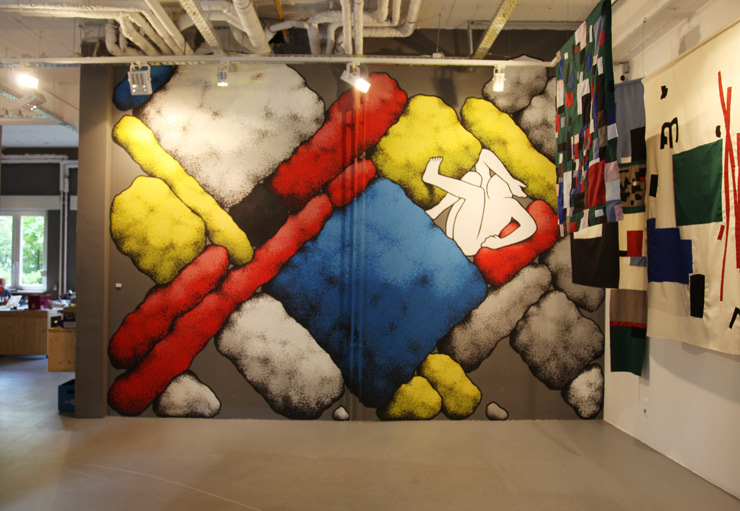
Daan Botlek. What In The World PM/12. Urban Nation Museum For Urban Contemporary Art. Berlin, May 19, 2017. (photo © Jaime Rojo)
The Project M series of exhibitions over the past three years with Urban Nation, of which this is the 12th, have featured curators and artists from many backgrounds, disciplines, and geographies as well. The myriad styles shown have included sculpture, stencil, wheat paste, collage, calligraphy, illustration, screen-printing, decoupage, aerosol, oil painting, and even acrylic brush. It has been a carefully guided selection of graffiti/Street Art/urban art/fine art across the 12 shows; all presented respectfully cheek to jowl, side by side – happily for some, uncomfortably for others.
The ultimate success of the Project M series, initiated by UN Artistic Director Yasha Young, is evident in just how far open it has flung the doors of expectation to the museum itself. When the house opens in four months it will be a reflection to some extent 140 or so artists who pushed open those doors with variety of styles emblematic of this moment – converging into something called Urban Contemporary.
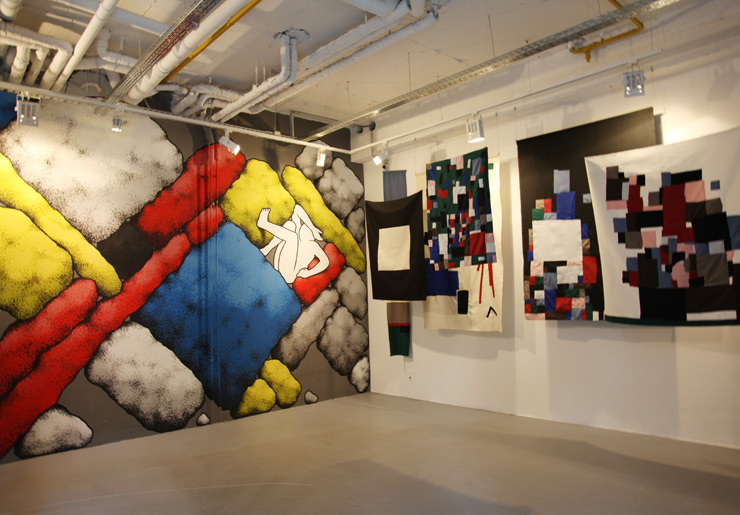
Daan Botlek and Ekta. What In The World PM/12. Urban Nation Museum For Urban Contemporary Art. Berlin, May 19, 2017. (photo © Jaime Rojo)
“What in the World” indeed: this show is in perfect alignment with the others in its wanton plumbing of the genres.
“I was trying to find people that are not part of the regular circuit – and I don’t mean that in a negative way but I mean there is kind of a regular circuit of muralism and Street Art right now – but I was looking for people who are really sort of on that periphery,” Pricco says. “Also because they are coming from these different parts of Europe, which to me sort of represents Juxtpoz’ reach, and they all kind of know each other but they’ve never really met – they all kind of bounce off of each other.”
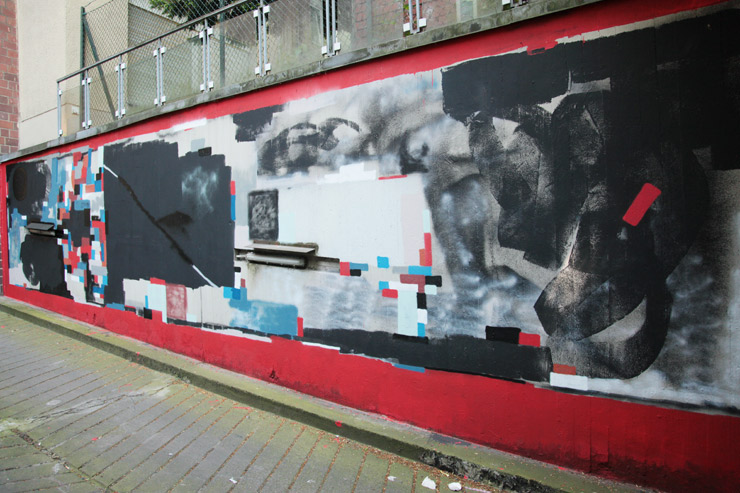
Ekta. What In The World PM/12. Urban Nation Museum For Urban Contemporary Art. Berlin, May 19, 2017. (photo © Jaime Rojo)
Brooklyn Street Art: This grouping sounds anathema to the loyalty that is often demanded by these scenes – particularly the various graffiti scenes in cities around the world. You are describing an artistic practice that has a sort of casual relationship to that scene.
Evan Pricco: Right. And I think all of these artists have these graffiti histories but they weren’t completely satisfied with that kind of moniker or label. So it is slightly expanding out now. And then there’s something about them that makes me think of crafts, especially with Serge who is more of a sign-painter. I felt that all of these people approached their work in a way that felt very craft-oriented to me, and I really appreciated that. That’s kind of what I wanted to show too.

Ekta. What In The World PM/12. Urban Nation Museum For Urban Contemporary Art. Berlin, May 19, 2017. (photo © Jaime Rojo)
Brooklyn Street Art: Each of these artists appears to have a certain familiarity with the art world that is outside a more strict definition of street culture – graffiti and Street Art and their tributaries. Would you say that you could see a certain development of personal style in this collection of primarily European artists that might be due to exposure to formal art history or other cultural influences?
Evan Pricco: Good question, and that could be the case for a few of the artists in the show, but I think the characteristics of each artist in the show is more of a result of the world getting smaller and influences and boundaries just blurring. You can see it Ermsy’s pop-culture mash-ups, or Erosie’s exploration of lettering and color; it’s not really about one place anymore but a larger dialogue of how far the work reaches now than ever before.
Erosie and I were having this conversation this morning about this, this idea of access and influences being so widespread. And that is exactly what I wanted to do. “What In the World” is sort of a nod to not really having to have boundaries, or a proper definition, but a feeling that something is happening. Its not Street Art, its not graffiti, but its this new wave that is looking out, looking in, and finding new avenues to share and make work.
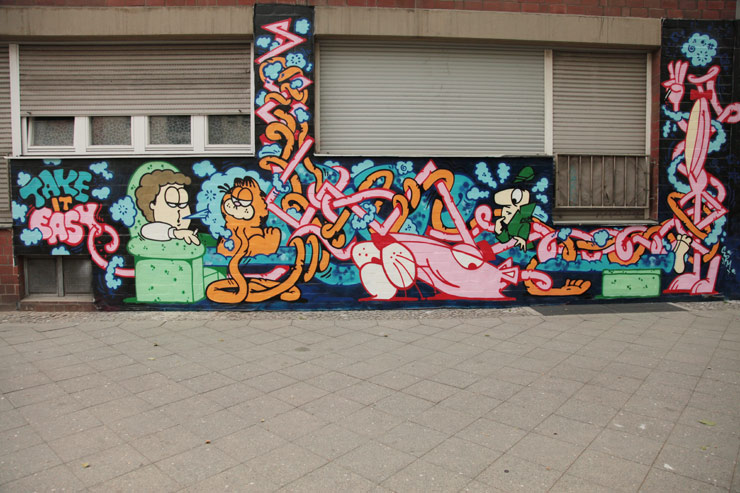
Ermsie. What In The World PM/12. Urban Nation Museum For Urban Contemporary Art. Berlin, May 19, 2017. (photo © Jaime Rojo)
Brooklyn Street Art: From comic books to politics to activism to abstract to sign painting, this show spans the Hi-Low terrain that Juxtapoz often seeks to embrace in many ways. Is it difficult to find common threads or narratives when countenancing such variety?
Evan Pricco: We have been so fortunate with the magazine that we have been able to expand the content in the last few years, and the threads are starting to connect solely based on the idea that the creative life is what you make of it. There may not be a direct connection between Serge Lowrider and Mark Ryden, but there is a connection in the idea of craftsmanship and skill and how one goes about applying that skill in the art world. That is always wanted I wanted to help bring to Juxtapoz – this idea that variety in the art world is healthy and finds its own connections just in the fact that it exists and is being made.
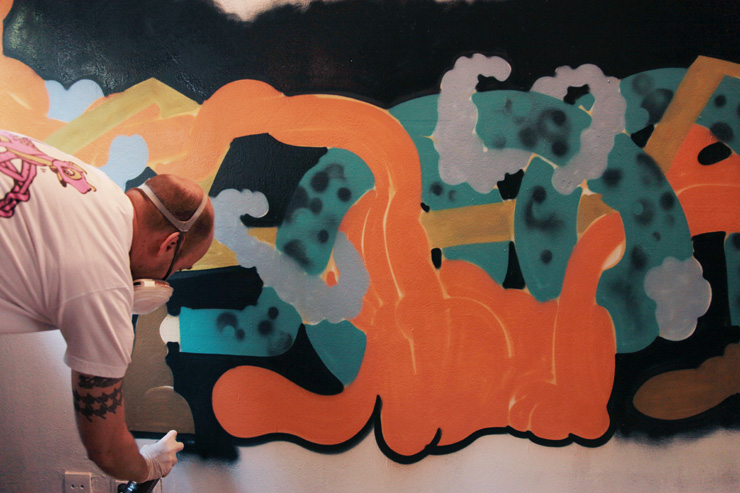
Ermsie at work on his indoor piece. What In The World PM/12. Urban Nation Museum For Urban Contemporary Art. Berlin, May 19, 2017. (photo © Jaime Rojo)
Brooklyn Street Art: Many of these names are not household names, though some have ardent fans within more narrow channels of influence. What role does a curator play by introducing these artworks/artists to a new audience and what connections would you like a viewer to make?
Evan Pricco: First and foremost, these are some of my absolute favorite artists making work right now. I do have the advantage of traveling a lot and meeting different people and seeing their process, but I really wanted to bring together a group that I hadn’t personally met but admired and communicated with from afar.
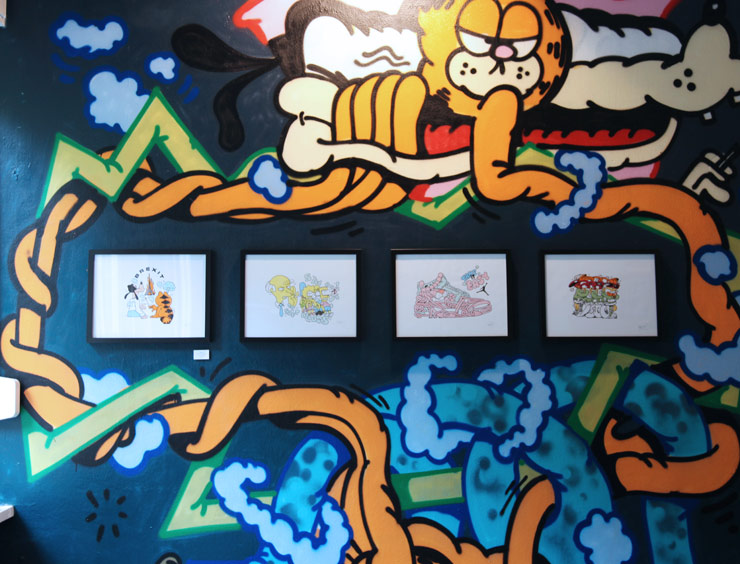
Ermsie. Detail. What In The World PM/12. Urban Nation Museum For Urban Contemporary Art. Berlin, May 19, 2017. (photo © Jaime Rojo)
I was thinking about this when I walked by Hyuro’s wall this morning. Her work is incredibly strong, and it has this really fascinating way of being a story and narrative from wall to wall while remaining fresh and really site-specific. Her work here just blew me away; its so subtle, has this really unique almost anonymous quality to it, but has a ton of thought and heart in it.
Really it would be great if the audience sees this and finds her other work, and starts seeing this really beautiful story emerging, these powerful political, social and economic commentaries. So really, I want that. I want this to be a gateway of looking at work and artists and then jumping into their really fantastically complex careers.
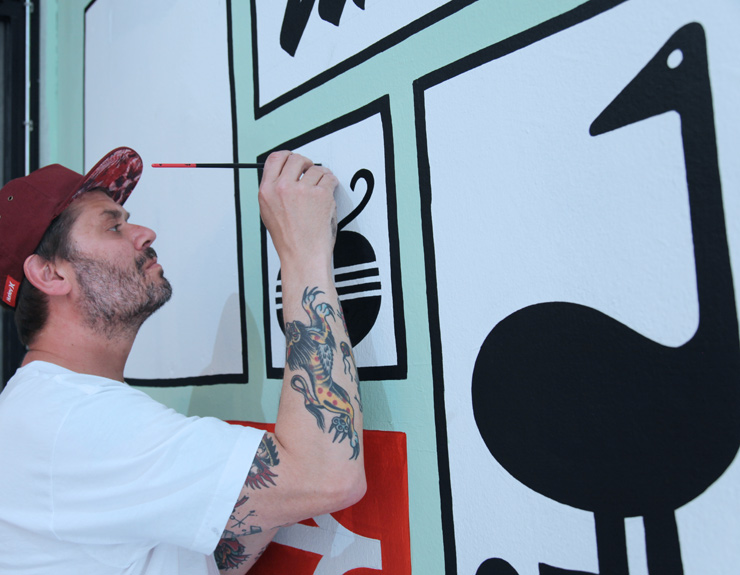
Serge Lowrider at work on his indoor piece. What In The World PM/12. Urban Nation Museum For Urban Contemporary Art. Berlin, May 19, 2017. (photo © Jaime Rojo)
Brooklyn Street Art: Urban Nation has invited curators from around the world and Berlin during these 12 “Project M” shows, each with a take on what “art in the streets” is, how it has evolved, and how it is affecting contemporary art. What makes this show stand out?
Evan Pricco: I really do think what makes it stand out is that it represents all the things Juxtapoz stands for; Opening up an audience to something new and different. I think there is an aesthetic that the Project M shows have had, which I like, but I didn’t want to repeat what everyone had done before.
This is most definitely a Juxtapoz show; I mean our damned Newsstand that Grotesk designed is right in the middle of the space. But that is like this “representation” of the print mag, and all the walls around it are the avenues the magazine can take you; sign painting, textiles, graffiti, abstraction, conceptual art, murals, comics, politics. … So maybe in that way, the fact that the magazine is 23 years old and has covered such a big history of Lowbrow, Graffiti and other forms of art, this is a nice encapsulation of the next wave and generation.
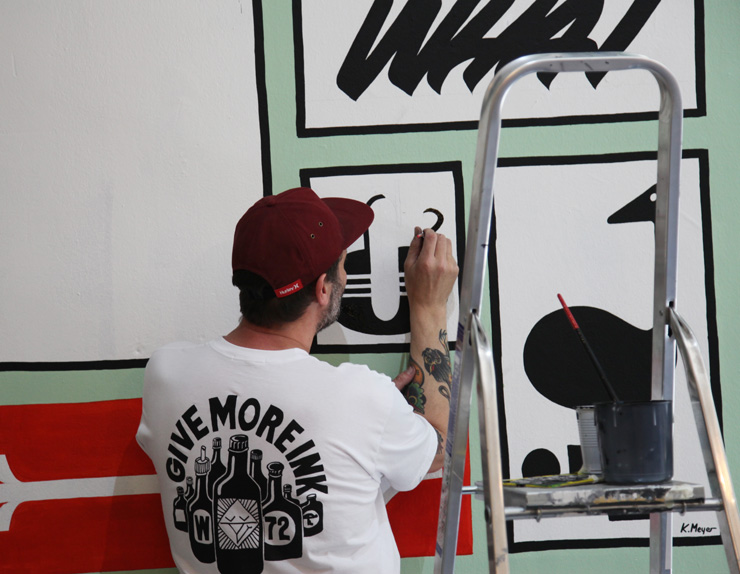
Serge Lowrider at work on his indoor piece. What In The World PM/12. Urban Nation Museum For Urban Contemporary Art. Berlin, May 19, 2017. (photo © Jaime Rojo)
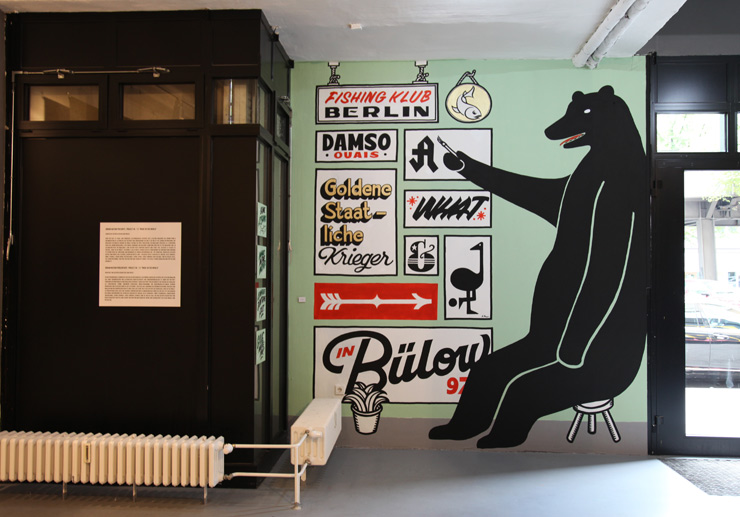
Serge Lowrider at work on his indoor piece. What In The World PM/12. Urban Nation Museum For Urban Contemporary Art. Berlin, May 19, 2017. (photo © Jaime Rojo)
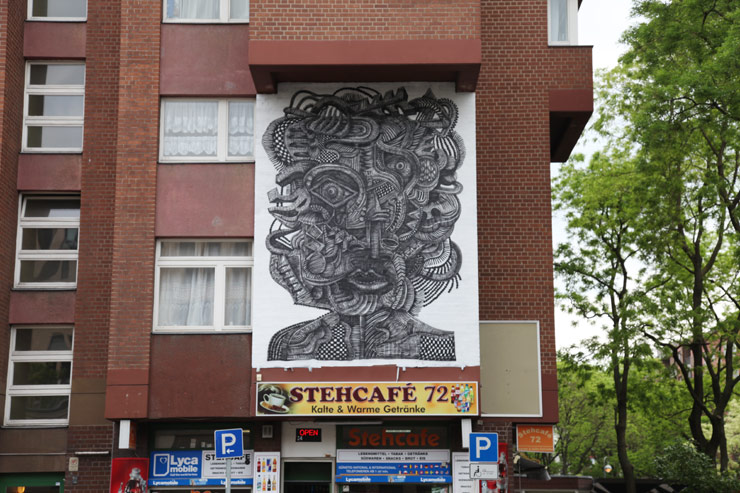
Zio Ziegler. What In The World PM/12. Urban Nation Museum For Urban Contemporary Art. Berlin, May 19, 2017. (photo © Jaime Rojo)
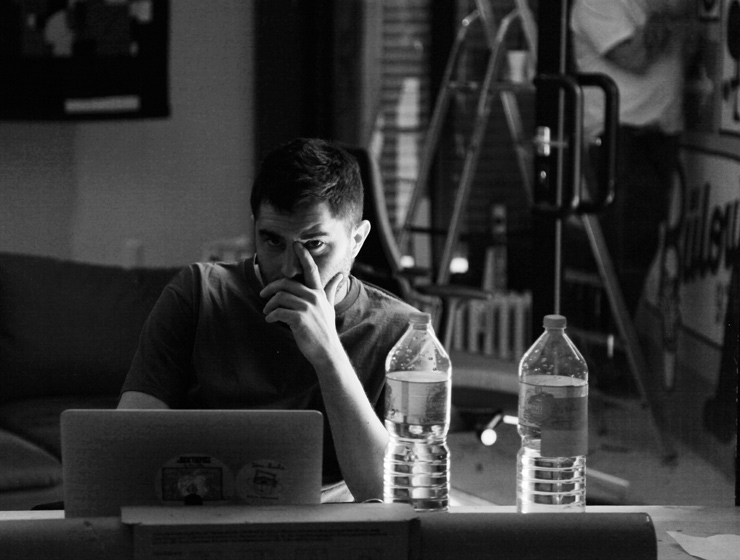
Evan Pricco. Curator of What In The World PM/12. Urban Nation Museum For Urban Contemporary Art. Berlin, May 19, 2017. (photo © Jaime Rojo)
“What In the World: The Juxtapoz Edition” presented by Urban Nation will be on display through June, 2017.
This article is also published on The Huffington Post
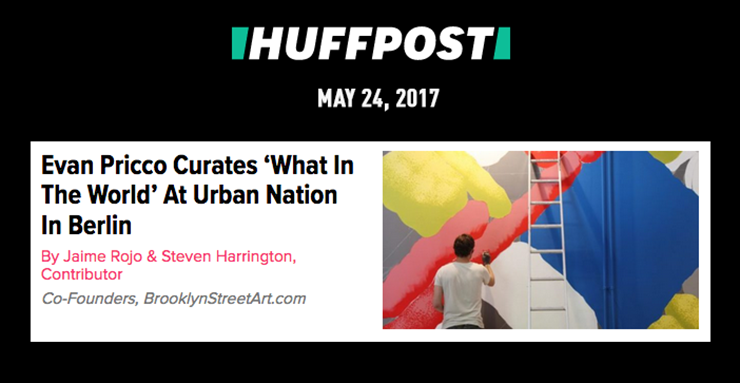
Other Articles You May Like from BSA:
This is the third year for Northern Norway's UPN Festival and this year it's on an Island called Røst and includes a collection of artists eager to do site-specific and environmental works - o...
The Amazon Forest - which furnishes 6% of our oxygen is being burned - an unthinkable event in human history. Evidence points to arson - incidences are up 80% over last year. Darkness now falls h...
Saype unveils his work at the foot of Broken Chair "All of us!" Art against weapons. SAYPE. "All of us!" Art against weapons. Place des Nations, Geneva. (photo © Saype) Now in his mid-thirti...
Our weekly focus on the moving image and art in the streets. And other oddities. Now screening : 1. Welcome To America Owen Dippie by Erin Dippie 2. Covert To Overt: Photography of Obey...
HotTea is being offered in the Caroli Church yard right now, floating above parishioners heads. Hot Tea. No Limit/Borås 2017. Borås, Sweden 09-2017 (photo © Jaime Rojo) Unveiled as the sun was set...
 BROOKLYN STREET ART LOVES YOU MORE EVERY DAY
BROOKLYN STREET ART LOVES YOU MORE EVERY DAY










